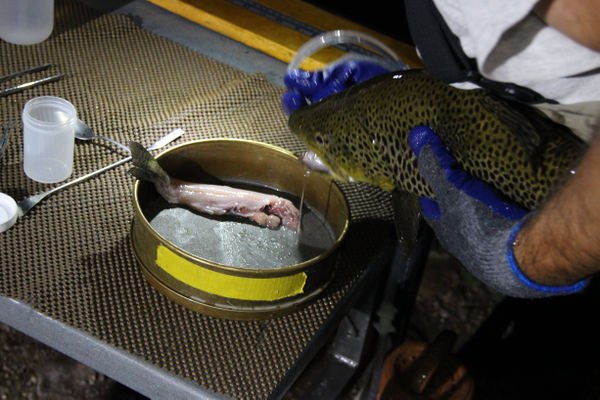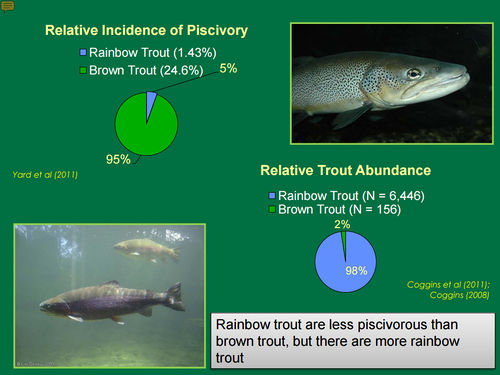Difference between revisions of "Rainbow trout / humpback chub predation studies"
Cellsworth (Talk | contribs) |
Cellsworth (Talk | contribs) |
||
| (6 intermediate revisions by the same user not shown) | |||
| Line 67: | Line 67: | ||
|- | |- | ||
|style="color:#000;"| | |style="color:#000;"| | ||
| + | |||
| + | '''2019''' | ||
| + | *[https://doi.org/10.3133/fs20193049 Yackulic, C.B., and Hull, J.B., 2019, Effects of water temperature, turbidity, and rainbow trout on humpback chub population dynamics: U.S. Geological Survey Fact Sheet 2019–3049, 4 p.] | ||
| + | |||
| + | '''2018''' | ||
| + | *[https://doi.org/10.1002/nafm.10216 Ward et al., 2018, Are hatchery‐reared rainbow trout and brown trout effective predators on juvenile native fish?: North American Journal of Fisheries Management] | ||
| + | |||
| + | '''2017''' | ||
| + | *[https://digitalcommons.usu.edu/cgi/viewcontent.cgi?article=1951&context=wats_facpub Pine et al. 2017. Growth of Endangered Humpback Chub in Relation to Temperature and Discharge in the Lower Colorado River. USU Watershed Sciences Faculty Publications] | ||
'''2015''' | '''2015''' | ||
| Line 74: | Line 83: | ||
*[http://www.usbr.gov/uc/rm/amp/twg/mtgs/13jan24/8_Healy.pdf Diets of trout in Bright Angel Creek] | *[http://www.usbr.gov/uc/rm/amp/twg/mtgs/13jan24/8_Healy.pdf Diets of trout in Bright Angel Creek] | ||
*[https://www.usbr.gov/uc/rm/amp/twg/mtgs/13jan24/8_Healy.pdf Diets and Food Availability of Nonnative Trout in Bright Angel Creek, Grand Canyon: Implications for Native Fish Conservation] | *[https://www.usbr.gov/uc/rm/amp/twg/mtgs/13jan24/8_Healy.pdf Diets and Food Availability of Nonnative Trout in Bright Angel Creek, Grand Canyon: Implications for Native Fish Conservation] | ||
| + | *[https://www.usbr.gov/uc/rm/amp/twg/mtgs/13jan24/9_Ward.pdf Effects of Water Temperature on Predation Vulnerability of Humpback Chub] | ||
'''2012''' | '''2012''' | ||
*[https://www.gcmrc.gov/about/ka/KA%202%20-%2010-18-11/PM%20Talks/Ward_Native%20nonnative%20interactions.pdf Native Nonnative Interactions (Ward)] | *[https://www.gcmrc.gov/about/ka/KA%202%20-%2010-18-11/PM%20Talks/Ward_Native%20nonnative%20interactions.pdf Native Nonnative Interactions (Ward)] | ||
*[https://www.gcmrc.gov/about/ka/KA%202%20-%2010-18-11/PM%20Talks/Yard_Native%20nonnative%20interactions.pdf Native Nonnative Interactions (Yard)] | *[https://www.gcmrc.gov/about/ka/KA%202%20-%2010-18-11/PM%20Talks/Yard_Native%20nonnative%20interactions.pdf Native Nonnative Interactions (Yard)] | ||
| + | *[https://www.gcmrc.gov/about/ka/KA%202%20-%2010-19-11/PM%20Talks/Yard%20KA%20Oct%2018%20(3_30)(No%202).pdf Chub, trout, predation] | ||
'''2011''' | '''2011''' | ||
| − | *[https:// | + | *[https://www.gcmrc.gov/files/2584/w-2584_2011-04-27-17-23-03-624_Trout%20Piscivory%20in%20the%20CR%20GC_Yard.pdf Yard et al. 2011 Trout piscivory in the Colorado River, Grand Canyon: Effects of turbidity, temperature, and fish prey availability. Transactions of the American Fisheries Society] |
|- | |- | ||
Latest revision as of 13:09, 27 November 2019
|
|
Introductions of nonnative salmonids, such as rainbow trout Oncorhynchus mykiss and brown trout Salmo trutta, have affected native fishes worldwide in unforeseen and undesirable ways. Predation and other interactions with nonnative rainbow trout and brown trout have been hypothesized as contributing to the decline of native fishes (including the endangered humpback chub Gila cypha) in the Colorado River, Grand Canyon. A multiyear study was conducted to remove nonnative fish from a 15-km segment of the Colorado River near the Little Colorado River confluence. We evaluated how sediment, temperature, fish prey availability, and predator abundance influenced the incidence of piscivory (IP) by nonnative salmonids. Study objectives were addressed through spatial (upstream and downstream of the Little Colorado River confluence) and temporal (seasonal and annual) comparisons of prey availability and predator abundance. Data were then evaluated by modeling the quantity of fish prey ingested by trout during the first 2 years (2003–2004) of the mechanical removal period. Field effort resulted in the capture of 20,000 nonnative fish, of which 90% were salmonids. Results indicated that the brown trout IP was higher (8–70%) than the rainbow trout IP (0.5–3.3%); however, rainbow trout were 50 times more abundant than brown trout in the study area. We estimated that during the study period, over 30,000 fish (native and nonnative species combined) were consumed by rainbow trout (21,641 fish) and brown trout (11,797 fish). On average, rainbow trout and brown trout ingested 85% more native fish than nonnative fish in spite of the fact that native fish constituted less than 30% of the small fish available in the study area. Turbidity may mediate piscivory directly by reducing prey detection, but this effect was not apparent in our data, as rainbow trout IP was greater when suspended sediment levels (range = 5.9–20,000 mg/L) were higher. [1] |
| -- |
-- |
-- |
|---|
|
|

